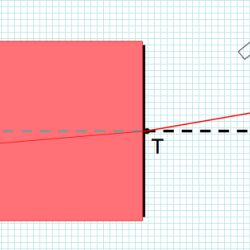Source Institutions
Source Institutions
Add to list Go to activity
Activity link broken? See if it's at the internet archive

Can gelatin (like Jell-O ®) change the speed of light? Learners investigate the refraction properties of gelatin to calculate its index of refraction and discover that as the light travels through the gelatin, its speed and wavelength also change. This activity offers learners a challenge to find the index of refraction of an everyday, intriguing, translucent substance outside the standard listing of materials and refraction indexes.
- 2 to 4 hours
- 1 to 2 hours
- $5 - $10 per group of students
- Ages 14 - 18
- Activity, Experiment/Lab Activity, Lesson/Lesson Plan
- English
Quick Guide
Materials List (per group of students)
- Wax paper sheets
- Graph paper (1/4 inch ruled with blue ink)
- Protractors
- Scientific calculators (like a TI-30)
- Protractors
- Laser pointers
- Binder clips big enough to grip the laser pointer and hold down the “on” switch.
- Knox gelatin (8 x 7 ounce envelopes)
- Desert gelatin with sugar (like Jell-O®) in red (strawberry) and yellow (pineapple).
- Cookie sheet (1/2 to 3/4 inch deep, smooth and non-stick surface) or brownie pan (8 x 8inches, 2 inches deep)
- 3 gelatin pans, preferably 8 x 8 x 2 inch brownie pans
- Measure cup with a 2-cup capacity
- Cooking spray (like Pam®)
- 2 packages of Knox® plain gelatin (4 envelopes per pack)
- 1 package of red gelatin (Jell-O® strawberry works well). Not sugar free. 1 package of yellow gelatin (Jell-O® pineapple). Not sugar free.
Subjects
-
Earth and Space Science
- Astronomy
-
Physical Sciences
-
Light and Optics
- Lasers
- Reflection and Refraction
-
Vibration and Waves
- Wave Properties
-
Motion and Forces
- Momentum and Velocity
-
Light and Optics
-
Mathematics
-
Algebra
- Equations and Inequalities
- Variables and Expressions
-
Data Analysis and Probability
- Data Analysis
- Data Collection
- Data Representation
-
Geometry
- Plane Geometry
- Measurement
-
Algebra
-
The Nature of Science
-
The Scientific Process
- Conducting Investigations
- Gathering Data
- Formulating Explanations
- Communicating Results
-
The Scientific Process
Informal Categories
- Food and Cooking
Audience
To use this activity, learners need to:
- see
- see color
- read
- touch
Learning styles supported:
- Involves teamwork and communication skills
- Involves hands-on or lab activities
Other
Components that are part of this resource:
- Teacher lesson plan
- Student worksheet
- Data table and plotting grid
- Experimental diagrams (for teacher)
- Experimental diagrams
Includes alignment to state and/or national standards:
This resource is part of:
Access Rights:
- Free access
By:
- The University of Texas McDonald Observatory
Rights:
- All rights reserved, The University of Texas McDonald Observatory, 2011
